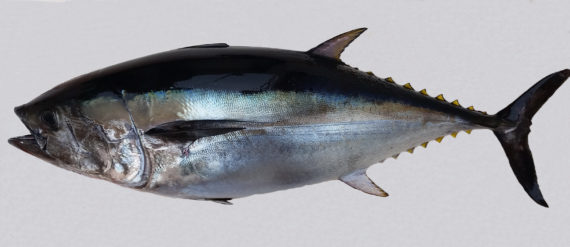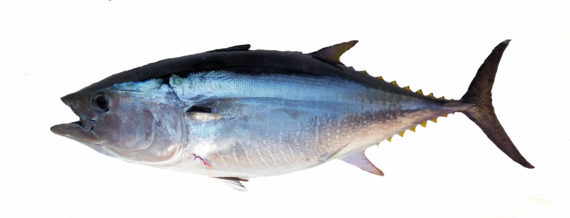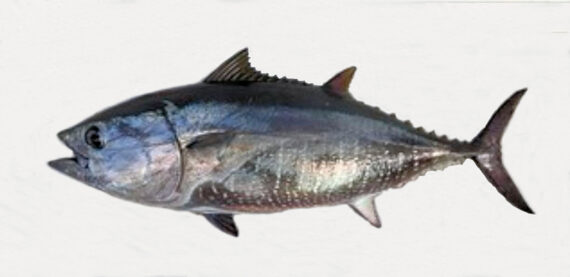Pacific Bluefin Tuna, Thunnus orientalis
 Pacific Bluefin Tuna, Thunnus orientalis. Fish caught from coastal waters off San Diego, California, June 2016. Fork Length: 61 cm (2 feet 0 inches). Catch, photograph, and identification courtesy of Chris Wheaton, Fullerton, California.
Pacific Bluefin Tuna, Thunnus orientalis. Fish caught from coastal waters off San Diego, California, June 2016. Fork Length: 61 cm (2 feet 0 inches). Catch, photograph, and identification courtesy of Chris Wheaton, Fullerton, California.
 Pacific Bluefin Tuna, Thunnus orientalis. Fish caught from coastal waters off San Diego, California, July 2016. Fork Length: 94 cm (3 feet 1 inches). Catch, photograph, and identification courtesy of Dan Fuller, San Diego, California.
Pacific Bluefin Tuna, Thunnus orientalis. Fish caught from coastal waters off San Diego, California, July 2016. Fork Length: 94 cm (3 feet 1 inches). Catch, photograph, and identification courtesy of Dan Fuller, San Diego, California.
 Pacific Bluefin Tuna, Thunnus orientalis. Fish caught from coastal waters off San Diego, California, September 2011. Fork Length: 94 cm (3 feet 1 inches). Catch, photograph and identification courtesy of Eli (obsessiveangling.wordpress.com).
Pacific Bluefin Tuna, Thunnus orientalis. Fish caught from coastal waters off San Diego, California, September 2011. Fork Length: 94 cm (3 feet 1 inches). Catch, photograph and identification courtesy of Eli (obsessiveangling.wordpress.com).
The Pacific Bluefin Tuna, Thunnus orientalis, is a member of the Mackerel or Scombridae Family, and is known in Mexico as atún cimarrón. The Pacific Bluefin Tuna was only recently determined to be a different species than the Bluefin Tuna, Thunnus thynnus of the Atlantic Ocean. Globally, there are eight species in the genus Thunnus, of which six are found in Mexican waters, two in the Atlantic, one in the Pacific and three in both the Atlantic and the Pacific Oceans.
The Pacific Bluefin Tuna is one of the largest and fastest fish in the ocean. They have an elongated, rounded, fusiform, large, “tuna-like” body that are deepest under the first dorsal fin and are aerodynamically designed for endurance and speed. They are dark metallic blue dorsally and transition to silvery white ventrally. Their anal fin and finlets are dusky yellow with black edges, their caudal fin is dark gray with the central keel being black in adults, their first dorsal fin is yellowish or bluish, and their second dorsal fin is reddish-brown. They have small eyes and a small mouth that ends at the front margin of the eyes and is equipped with small and slender conical teeth. Their anal fin has 1 spine and 12 to 15 rays followed by 8 or 9 finlets; their caudal fin is deeply forked and its base has 2 small keels separated by a larger keel; their first dorsal fin has 13 to 15 spines; the second dorsal fin is set close to the first and is higher than the first with 13 to 15 spines followed by 8 or 9 finlets; and, their pectoral fins are short and do not reach past the first dorsal fin. They have 32 to 40 gill rakers on the first arch and are covered with small scales.
The Pacific Bluefin Tuna is found in temperate waters from the surface to depths up to 550 meters (1,800 feet); they are also known to range in tropical waters. They reach a maximum of 3.3 m (10 feet 10 inches) in length and 550 kg (1,210 lbs) in weight. As of January 1, 2024, the International Game Fish Association world record stood at 412 kg (907 lbs) with the fish caught in coastal waters off New Zealand in February 2014. The Pacific Bluefin Tuna are the largest of all tuna and are significantly larger than the Bigeye Tuna, the Southern Bluefin Tuna, and the Yellowfin Tuna. They travel in large schools of similar-sized fish that include other tuna. Their snouts have magnetite which is believed to help them detect the earth’s magnetic field for navigation. They have the ability to regulate their body temperature to levels well above their environment allowing them to tolerate fairly large changes in water temperatures, thus giving them added strength, speed, and endurance. They are mainly an offshore species that will approach shore in pursuit of small baitfish when the water is clear and food is abundant. They are voracious predators that feed on a wide variety of small schooling fish (herrings and mackerels), crabs, krill, squid and various sessile organisms. They have been clocked at 30 mph during short sprints enabling them to catch prey that cannot be caught by slower predators. They consume up to 5% of their body weight on a daily basis and must remain in constant motion to obtain adequate supplies of oxygen. Reproduction is oviparous with each female releasing between 5,000,000 and 25,000,000 eggs (with larger fish producing more eggs than smaller fish). Fertilization is external with pelagic eggs and larvae. Fish do not reach sexual maturity for 5 years at which point they are over 50 kg (110 lbs). They have a lifespan of up to twenty-six years.
The Pacific Bluefin Tuna reside primarily in the Northern Pacific Ocean. They spawn off Okinawa, between Taiwan and the Philippines, and in the Sea of Japan. In Mexican waters they are found along the entire west coast of Baja and along the east coast of Baja south from La Paz, Baja California Sur. They are highly migratory and a certain percentage of the population migrates 6,000 miles in as little as 55 days to the Eastern Pacific and can be found 3 to 200 miles off the coast of Baja California from June to September. They remain in the Eastern Pacific for three or four years and then migrate back to the Western Pacific to spawn which is why very few large fish are caught in Mexican and United States waters.
The Pacific Bluefin Tuna is similar in appearance to several other tuna, including the Albacore, Thunnus alaunga, the Bigeye Tuna, Thunnus obesus, and the Yellowfin Tuna, Thunnus albacares, but all 3 have pectoral fins that reach to at least the second dorsal fin base.
From a conservation perspective the Pacific Bluefin Tuna is currently considered to be VULNERALBE due to overfishing, inadequate regulations covering juvenile mortality, and spawning areas for adults. Conservation measures have been difficult to establish and enforce due to the Pacific Bluefin Tuna’s vast geographic range. In the Tropical Eastern Pacific the retention of juveniles has been banned and an annual limit of 5,000 tons has been established. In both Mexico and the United States the recreational daily limit of two fish per angler has recently been established. Several conservation groups have placed the Pacific Bluefin Tuna on a “do not consume” list as they are reported to contain mercury and PCBs. Japan is leading a farming effort for the Pacific Bluefin Tuna and has successfully farmed previously hatched fish in 1979, bred them in 2002, and raised third generation fish in 2007. The Pacific Bluefin Tuna are also subject to tuna “ranching” with small fish being caught in purse seines and transported to holding pens off Ensenada, Baja California for fattening. The Pacific Bluefin Tuna is a highly seasonal game fish targeted, when in residence, by recreational anglers. They are considered a highly valued important international commercial fish and are heavily pursued. The majority are taken with purse seines, longliners or by hook and line by Japanese, Mexican and by United States fishermen fishing in Mexican waters. Historically they have been caught at the 40,000 tons per year level, however, lately these annual levels have dropped by about 50% with greater than 90% of the catch being juveniles. Currently surveys have documented a 96% reduction in populations. They are highly prized for their food value and are coveted, primarily in Japan, for sashimi where they can command extraordinary prices: a 300-pound fish can be valued at $100,000 thus driving up fishing pressure. In 2013, a 222 kg (488 lbs) Pacific Bluefin Tuna sold at auction in Tokyo’s Tsukiji Fish Market for $1,800,000 or $3,700 per pound.